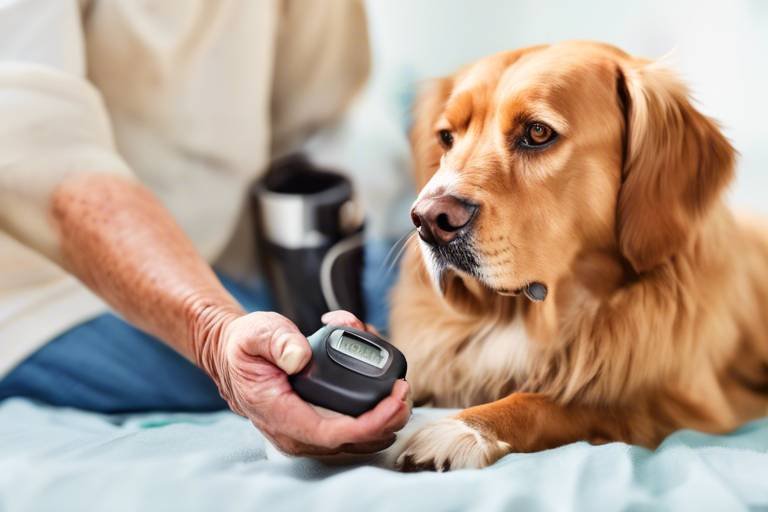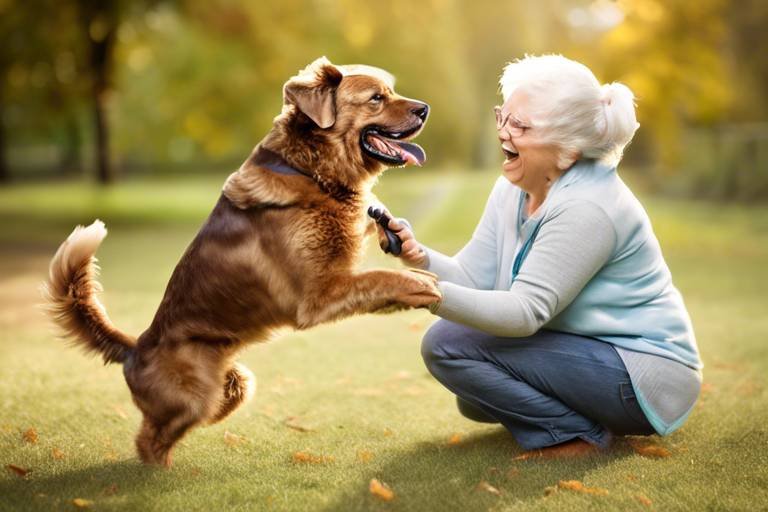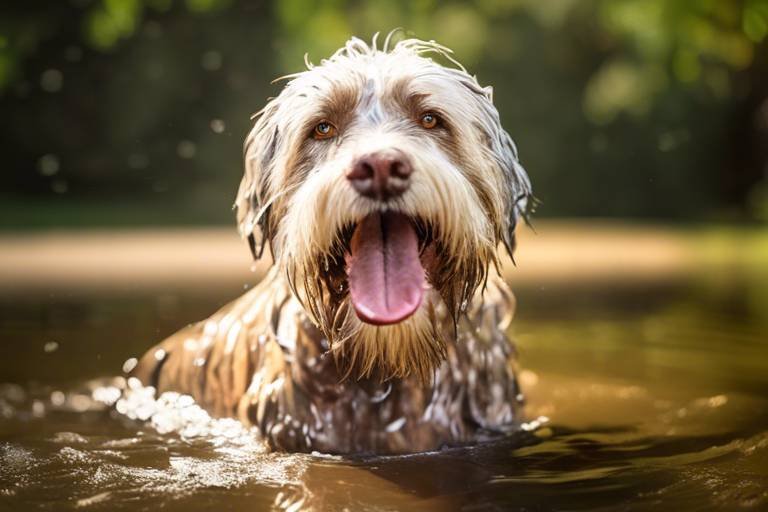The Best Outdoor Activities for Senior Dogs
As our furry companions age, their needs and preferences shift, just like the seasons change. Senior dogs may not have the same energy levels they once did, but that doesn’t mean they should miss out on the joys of outdoor activities. In fact, engaging in the right outdoor activities can significantly enhance their physical health, mental stimulation, and overall happiness. Think of it as giving them a second wind—a chance to enjoy the great outdoors in a way that's tailored just for them. This article dives into a variety of outdoor activities that are perfect for senior dogs, ensuring they stay active, engaged, and safe during their golden years.
There's something magical about a gentle walk. It's not just about the exercise; it's also about the bonding experience between you and your senior dog. These walks can promote cardiovascular health and provide essential mental stimulation. To make these strolls enjoyable, consider the following tips:
- Choose the Right Time: Early mornings or late afternoons are often cooler and more comfortable.
- Pick a Comfortable Pace: Allow your dog to set the pace. Slow and steady wins the race!
- Explore New Routes: Change up your walking trails to keep things exciting and engaging.
Also, keep an eye out for signs of fatigue. If your dog starts lagging behind or seems disinterested, it might be time to head home. Remember, the goal is to enjoy these moments together, not to exhaust them!
Swimming is a fantastic low-impact exercise, especially for senior dogs with joint issues. The buoyancy of water helps alleviate stress on their joints while providing a full-body workout. But before you dive in, it’s important to introduce your dog to swimming in a safe and positive way. Start by letting them wade in shallow water, gradually building their confidence as they splash around. Always supervise them closely to ensure they feel secure in the water.
Selecting a safe and accessible swimming spot is crucial. Look for calm lakes, dog-friendly pools, or even the ocean, as long as the waves aren’t too rough. A quiet environment helps minimize distractions and allows your senior dog to enjoy the experience without stress. Also, consider the temperature of the water—too cold can be uncomfortable, while too warm can lead to overheating.
Implementing safety measures is essential for a fun swimming experience. Here are some precautions to keep in mind:
- Use a Life Vest: A life vest designed for dogs can provide extra buoyancy and security.
- Supervise at All Times: Always keep an eye on your dog while they’re in the water.
- Know Your Dog's Limits: If they seem tired or overwhelmed, it’s time to take a break.
Just like humans, dogs need to stay hydrated, especially during swimming sessions. Make sure to bring fresh water and take breaks often. Watch for signs of fatigue, such as heavy panting or reluctance to continue swimming. It's important to allow your senior dog to rest and recharge to ensure they have a positive experience.
Interactive playtime is another excellent way to keep your senior dog engaged and happy. Activities like gentle fetch, tug-of-war, or even hide-and-seek can stimulate their minds and strengthen your bond. Choose toys that are easy for them to handle, and keep the games low-impact to avoid any strain on their joints. Remember, it's not just about physical activity—it's about creating joyful memories together!
Exploring nature provides sensory enrichment that can be incredibly beneficial for senior dogs. New sights, sounds, and smells can awaken their curiosity and keep their minds sharp. When introducing your dog to new environments, start slowly. Take them to local parks or nature trails, allowing them to explore at their own pace. This gradual approach helps them feel secure while experiencing the wonders of the great outdoors.
Hiking on gentle trails can be a rewarding experience for both you and your senior dog. Not only does it offer a change of scenery, but it also allows them to enjoy diverse scents and sights. When planning a hike, choose trails that are well-maintained and not too strenuous. Bring along plenty of water and take breaks to allow your dog to rest and absorb their surroundings.
Picnics can be a delightful way for senior dogs to socialize and enjoy the fresh air. Plan a dog-friendly picnic by packing some healthy treats for your furry friend. Ensure that the area is safe and free from hazards. Set up a cozy spot with a blanket, and let your dog relax while enjoying the sights and sounds of nature. This can be a wonderful way to bond and create lasting memories.
Q: Can senior dogs still enjoy outdoor activities?
A: Absolutely! Senior dogs can benefit greatly from outdoor activities tailored to their needs. Just be mindful of their energy levels and physical limitations.
Q: What are the best outdoor activities for senior dogs?
A: Gentle walks, swimming, interactive playtime, nature exploration, trail hiking, and picnics are all great options for senior dogs.
Q: How can I keep my senior dog safe during outdoor activities?
A: Always supervise your dog, choose safe environments, provide hydration, and take breaks as needed.

Gentle Walks
Gentle walks are not just a leisurely stroll; they are a vital part of maintaining your senior dog's physical health and mental well-being. As our furry friends age, their energy levels may decrease, but that doesn’t mean they should miss out on the joys of the outdoors. In fact, regular walks can help promote cardiovascular health, keep their joints flexible, and provide essential mental stimulation. Think of these walks as a way to keep the spark alive in your dog’s golden years!
When planning a gentle walk, consider the pace and distance. Senior dogs may tire more quickly, so it’s important to take it slow and allow for plenty of breaks. You might find that your dog enjoys a shorter route with more frequent stops to sniff around and explore. After all, for a dog, a walk is as much about the journey as it is about the destination!
Here are some tips to make these walks enjoyable and safe:
- Choose the Right Time: Early mornings or late evenings are often cooler and more comfortable for older dogs, especially during hot weather.
- Use a Comfortable Harness: A well-fitted harness can provide better support and comfort for your senior dog, reducing strain on their neck.
- Stay Hydrated: Always carry water for both you and your dog. Frequent sips will help keep your furry friend hydrated.
- Watch for Signs of Fatigue: Keep an eye on your dog’s behavior. If they seem tired or reluctant to continue, it’s time to head home.
Additionally, consider the terrain. Opt for flat, even surfaces rather than steep hills or rocky paths that could pose a risk of injury. Parks with soft grass and shaded areas are ideal, as they provide a comfortable environment for your dog to explore without overexertion.
One of the greatest joys of walking with your senior dog is the opportunity for bonding. These moments spent together create lasting memories and strengthen your relationship. So, grab that leash, step outside, and let your senior dog enjoy the sights, sounds, and smells of the great outdoors. You might just find that these gentle walks become the highlight of both your days.
Q: How long should I walk my senior dog?
A: The ideal duration depends on your dog’s health and stamina. Generally, aim for 15 to 30 minutes, adjusting based on their energy levels.
Q: What signs indicate my dog is tired during a walk?
A: Look for signs like lagging behind, panting excessively, or laying down. If you notice these signs, it’s best to take a break or head home.
Q: Can I take my senior dog on a hike?
A: Yes, but choose easy, flat trails and keep the hike short. Always monitor your dog for fatigue and provide plenty of breaks.
Q: Should I use a leash or allow my dog to roam free?
A: It’s safest to keep your senior dog on a leash, especially in unfamiliar areas, to prevent them from straying too far or encountering hazards.

Swimming Sessions
Swimming is not just a fun way for dogs to cool off; it's also a fantastic low-impact exercise that can work wonders for senior dogs. As our furry friends age, their joints can become stiff, and their mobility may decline. This is where swimming shines! The buoyancy of water supports their weight, allowing them to move freely without putting too much strain on their bodies. Imagine your dog gliding through the water, feeling the freedom of movement, and enjoying the refreshing splash—it's like a mini-vacation for them!
When introducing your senior dog to swimming, it's essential to take it slow. Start by letting them wade into shallow water, allowing them to get comfortable with the sensation. You can encourage them with toys or even join them in the water, creating a safe and supportive environment. Remember, every dog is different; some may take to water like a duck, while others might be a bit more hesitant. Patience is key! The goal is to make this experience enjoyable and stress-free.
Finding the perfect swimming spot is crucial for your dog's safety and enjoyment. Look for locations that are calm, shallow, and free from strong currents. A dog-friendly lake or a shallow beach area can be ideal. Always check the water quality and ensure there are no harmful substances or sharp objects lurking beneath the surface. It’s like choosing the right playground for your child—safety first!
Before you dive in, it's essential to implement some safety measures. Consider investing in a dog life vest, especially if your dog is not a strong swimmer or if you're venturing into deeper waters. These vests not only provide buoyancy but also make it easier for you to spot your dog. Additionally, never leave your senior dog unattended while swimming. Just like a lifeguard at the beach, your watchful eye can make all the difference in ensuring a safe and enjoyable experience.
Swimming can be exhilarating, but it's vital to keep an eye on your senior dog's hydration levels. Make sure to bring fresh water along and encourage them to take breaks. After all, even the most energetic swimmers need to rest! Watch for signs of fatigue, such as heavy panting or decreased enthusiasm. If you notice these signs, it's time to take a break—think of it as a well-deserved spa day for your pup.
In conclusion, swimming sessions can be a delightful and beneficial activity for senior dogs. With the right precautions and a little bit of planning, you can help your furry friend enjoy the water while staying safe and healthy. So, grab that life vest, find a dog-friendly spot, and dive into some splashing good fun!
- Can all senior dogs swim? While many dogs have a natural instinct to swim, not all senior dogs will feel comfortable in the water. It's essential to assess your dog's comfort level and introduce them to swimming gradually.
- How often should my senior dog swim? Swimming can be a great exercise, but moderation is key. Start with short sessions and gradually increase the duration as your dog becomes more comfortable and confident.
- What if my dog doesn't like swimming? If your dog shows signs of fear or discomfort, don't force them into the water. Instead, consider alternative low-impact activities like gentle walks or playing fetch on the shore.
Choosing the Right Location
When it comes to choosing the right location for your senior dog to enjoy a swimming session, several factors must be taken into account to ensure a safe and enjoyable experience. First and foremost, accessibility is key. Look for places that are easy to reach, avoiding steep hills or challenging terrains that could strain your dog’s joints. Imagine your furry friend trying to navigate a rocky path—it's not only stressful for them but can also lead to injuries.
Next, consider the water quality. Opt for clean, clear water bodies, as murky or polluted environments can pose health risks. A pristine lake or a well-maintained dog-friendly beach can be a perfect spot. Additionally, check for any local regulations or restrictions regarding dogs in the area. Some places may have specific rules, and it’s best to be informed to avoid any surprises.
Another vital aspect is the environment around the swimming area. Look for locations that provide a calm and peaceful atmosphere, away from loud noises and chaotic crowds. Senior dogs, much like humans, can become anxious in bustling environments. A serene spot with gentle waves can be more inviting and relaxing. You might also want to scout for shaded areas nearby where your dog can take a break from the sun after splashing around.
Finally, it’s essential to assess the depth of the water. For senior dogs, shallow areas are preferable, allowing them to wade in comfortably without the risk of sudden deep water. A gradual slope is ideal, enabling your dog to enter and exit the water safely. Remember, the goal is to create a fun and stress-free experience that your senior dog will enjoy!
Safety Precautions
When it comes to swimming with your senior dog, safety should always be your top priority. Just like humans, dogs can face risks in the water, especially as they age. To ensure your furry friend has a delightful experience without unnecessary hazards, consider implementing the following precautions:
First and foremost, always use a life vest designed specifically for dogs. This is especially important for senior dogs who may have reduced stamina or mobility. A good life vest not only keeps your dog afloat but also provides added visibility in the water, making it easier for you to keep an eye on them. When selecting a life vest, make sure it fits snugly but comfortably, allowing for ease of movement.
Next, supervision is crucial. Even if your dog is a seasoned swimmer, never leave them unattended in the water. Accidents can happen in the blink of an eye, so it’s essential to be vigilant. Consider bringing a friend along; having an extra set of eyes can help ensure your dog’s safety while you enjoy the water together.
Additionally, it’s important to choose the right time for your swimming sessions. Opt for cooler parts of the day, such as early morning or late afternoon, to avoid overheating. Senior dogs are more susceptible to heat stress, so keeping their comfort in mind is vital. Always check the water temperature; ideally, it should be warm but not hot. If you wouldn’t want to swim in it, neither should your dog!
Another aspect to consider is the environment. Look for calm waters without strong currents or waves. A lake or a quiet beach can be perfect, while a busy river might pose challenges. If you’re unsure about the conditions, it’s best to err on the side of caution and choose a different location. Before entering the water, assess the area for any potential hazards, such as sharp rocks, broken glass, or other debris that could harm your dog.
Finally, always keep a close watch on your dog’s behavior in the water. If you notice signs of fatigue, such as heavy panting or struggling to stay afloat, it’s time to bring them back to shore. Remember to give your senior dog regular breaks to rest and hydrate. Bring along fresh water, as swimming can be tiring work even for the most seasoned swimmers. By observing your dog closely and taking these precautions, you can ensure a safe and enjoyable swimming experience for both of you!
- What type of life vest should I choose for my senior dog? Look for a vest that fits snugly, is made of durable materials, and has handles for easy lifting.
- How can I tell if my dog is tired while swimming? Signs include heavy panting, slowing down, or struggling to keep their head above water.
- Can all senior dogs swim? While many can, some may have health issues that make swimming difficult. Always consult your vet first.
- What should I do if my dog is scared of water? Gradually introduce them to water in a calm environment and use positive reinforcement to encourage them.
Hydration and Rest
When it comes to keeping your senior dog happy and healthy during swimming sessions, are two critical factors that can’t be overlooked. Just like us, dogs can become fatigued after physical activity, and that’s especially true for our older furry friends. Their bodies may not be as resilient as they once were, and it’s essential to monitor their energy levels closely. Imagine taking a long swim in the ocean; you’d want to take breaks, sip on some water, and relax on the shore, right? Your dog deserves the same consideration!
First and foremost, always ensure that your senior dog has access to fresh water before, during, and after swimming. A good rule of thumb is to offer them water every 15-20 minutes while they're enjoying their time in the water. This helps prevent dehydration and keeps their energy levels up. Dogs can’t always tell us when they’re thirsty, so it’s our job to keep them hydrated. You can even bring a portable water bowl or a collapsible dish to make this easier during your outings.
Now, let’s talk about rest. After a vigorous swim, your dog may need some time to recover. Look for signs of fatigue, such as heavy panting, decreased energy, or reluctance to continue swimming. If you notice these signs, it’s time for a break. Find a comfortable spot on the shore or a shaded area where they can relax. This is not just about giving them a pause; it’s about allowing them to recharge their batteries. Think of it as a mini-vacation after a fun day at the beach!
To help you keep track of your dog’s hydration and rest needs, here’s a quick reference table:
| Activity | Hydration Tips | Rest Signs |
|---|---|---|
| Swimming | Offer water every 15-20 minutes | Heavy panting, slowing down |
| Playing Fetch | Keep a water bowl nearby | Hiding, sitting down |
| Walking | Bring a portable water bottle | Excessive drooling, lagging behind |
Remember, a well-hydrated and rested dog is a happy dog! By keeping an eye on their hydration levels and recognizing when they need to take a breather, you’re ensuring that their swimming experience is not only enjoyable but also safe. After all, the goal is to create lasting memories with your senior dog during their golden years!
1. How often should I let my senior dog swim?
It’s best to limit swimming sessions to about 20-30 minutes, depending on your dog's stamina. Always monitor them for signs of fatigue.
2. Can all senior dogs swim?
Not all senior dogs are natural swimmers. If your dog has never been in water before, consider introducing them slowly and safely.
3. What should I do if my dog seems tired after swimming?
If your dog shows signs of tiredness, take them out of the water, provide fresh water, and let them rest in a cool, shaded area.
4. How can I keep my senior dog cool while swimming?
Choose swimming locations with shaded areas, and consider bringing a portable fan or a cooling mat for after swimming.
Interactive Playtime
When it comes to keeping our senior dogs happy and healthy, is a game changer! Just like humans, dogs thrive on social interaction and mental stimulation, especially as they age. Engaging in play not only strengthens the bond between you and your furry friend, but it also keeps their minds sharp and bodies agile. Imagine a world where your dog can still chase after their favorite toy, even if it's at a slower pace. Sounds delightful, right?
One fantastic way to keep your senior pup engaged is through gentle games that cater to their physical abilities. For instance, a game of fetch can be adapted by using softer balls or toys that are easier for them to carry. You can also shorten the distance to accommodate their stamina. Remember, the goal is to have fun, not to exhaust them! You might even consider using a treat-dispensing toy to encourage them to play independently while still providing mental stimulation.
Another excellent option is hide and seek. This game can be a delightful way to engage your dog's natural instincts. You can hide somewhere in your home or yard and call your dog to find you. This not only gets them moving but also encourages them to use their sense of smell and problem-solving skills. Just be sure to keep it light and never too challenging, as we want to ensure they enjoy the experience without frustration.
For those days when the weather isn’t cooperating, consider setting up an indoor obstacle course. Use cushions, chairs, or even boxes to create a fun and safe space for your dog to navigate. This activity can be a great workout for their minds and bodies while providing an opportunity for you to bond and interact. Just like a kid with a new toy, your senior dog will likely get excited about exploring new challenges!
As with any activity, it’s essential to monitor your dog during playtime. Look for signs of fatigue or discomfort, and be ready to take breaks. After all, the last thing we want is for our beloved companions to overexert themselves. Keeping play sessions short and sweet, around 10 to 15 minutes, can help maintain their energy levels while still providing ample enjoyment.
Finally, don’t forget to mix things up! Dogs, just like us, can get bored with the same old routine. Introducing new toys, changing the location of play, or trying out different activities can keep their interest piqued. Whether it’s a game of tug-of-war, a gentle chase, or simply rolling around together, the key is to keep it fun and engaging!
Q: How often should I engage my senior dog in interactive playtime?
A: Aim for short sessions of interactive play a few times a week, adjusting based on your dog’s energy levels and interest.
Q: What types of toys are best for senior dogs?
A: Look for soft, lightweight toys that are easy to carry and gentle on their teeth. Interactive toys that dispense treats can also be great for mental stimulation.
Q: Can I play fetch with my senior dog?
A: Yes! Just modify the game to suit their physical abilities by using softer toys and keeping the distance shorter.
Q: How do I know if my dog is tired during play?
A: Watch for signs such as heavy panting, slowing down, or losing interest. If you notice these signs, it’s time to take a break.

Nature Exploration
Exploring nature is like opening a treasure chest for senior dogs, filled with new scents, sounds, and sights that can invigorate their spirits and stimulate their minds. Imagine your furry friend, tail wagging and nose twitching, as they encounter the rustling leaves, the chirping birds, and the gentle breeze that carries the scent of blooming flowers. This sensory adventure is not only enjoyable but also essential for their overall well-being. However, it’s crucial to approach nature exploration with a plan to ensure your senior dog remains safe and comfortable while soaking in the great outdoors.
When introducing your senior dog to new environments, start with short excursions to nearby parks or nature trails. These outings can be a delightful change of scenery, allowing your dog to experience the beauty of nature without overwhelming them. Pay attention to your dog's energy levels and comfort; if they seem hesitant or tired, it might be best to cut the adventure short. Remember, the goal is to create positive experiences that encourage your dog to embrace the outdoors.
One of the best ways to enhance your senior dog's nature exploration is through gentle hikes. Hiking on easy, well-maintained trails can provide a perfect opportunity for your dog to enjoy diverse scents and sights. Look for trails that are not too steep or challenging, as senior dogs may have limited stamina and mobility. To ensure a successful hike, consider these tips:
- Choose the Right Time: Early mornings or late afternoons are ideal for avoiding the heat of the day.
- Stay Hydrated: Always carry fresh water for your dog, and take breaks to allow them to drink and rest.
- Watch for Signs of Fatigue: If your dog starts to lag behind or seems less enthusiastic, it’s time to head back.
Another delightful way to enjoy nature is through picnic outings. Picture this: a serene park, a cozy blanket laid out, and your senior dog lounging beside you as you enjoy a meal together. Picnics offer a relaxed atmosphere where your dog can socialize with other dogs and people while enjoying the fresh air. When planning a dog-friendly picnic, consider bringing along some tasty treats for your furry friend, such as:
- Homemade dog biscuits
- Fresh fruits like apple slices or blueberries (ensure they are dog-safe)
- Plenty of fresh water to keep them hydrated
However, while enjoying these outdoor adventures, always keep an eye on your dog's behavior and comfort level. Some dogs may become anxious in crowded areas or unfamiliar surroundings, so it’s essential to monitor their reactions and adjust your plans accordingly. By being attentive and aware, you can help your senior dog thrive in nature, creating cherished memories that you both will treasure for years to come.
Q: How can I tell if my senior dog is enjoying nature exploration?
A: Look for signs of excitement, such as wagging tails, playful behavior, and curiosity about their surroundings. If your dog seems relaxed and engaged, they are likely enjoying the experience.
Q: What should I do if my senior dog gets tired during a hike?
A: It's important to listen to your dog. If they show signs of fatigue, such as lagging behind or lying down, take a break or head back to the starting point. Always prioritize their comfort and safety.
Q: Are there specific trails that are better for senior dogs?
A: Yes! Look for trails that are flat, well-maintained, and not overly crowded. Avoid steep inclines and rough terrain to ensure a safe and enjoyable experience for your senior dog.
Trail Hiking
Hiking with your senior dog can be one of the most rewarding experiences, both for you and your furry friend. Imagine a gentle trail winding through a peaceful forest, the sun filtering through the leaves, and your dog happily sniffing every new scent along the way. is not just about exercise; it's a chance for your senior dog to explore new environments and engage their senses in a way that is both stimulating and enjoyable. However, it's essential to choose the right trails and take precautions to ensure that your dog has a safe and pleasant experience.
When selecting a trail, look for gentle slopes and well-maintained paths. Avoid steep or rocky terrains that could be challenging for older dogs with joint issues or limited mobility. A good rule of thumb is to choose trails that are 2 to 3 miles long with plenty of shady spots for breaks. Remember, your senior dog may not be as spry as they once were, so it's important to listen to their needs. If they seem tired or reluctant to continue, it’s perfectly fine to turn back early.
Before you hit the trail, make sure you have the right gear. A comfortable harness can provide extra support, and a leash is essential for keeping your dog close, especially in areas where wildlife might be present. Don’t forget to pack plenty of water and a collapsible bowl to keep your pup hydrated. During your hike, take frequent breaks to let your dog rest and recharge. This will not only help prevent exhaustion but also give them a chance to take in the sights and sounds around them.
Here are a few tips to make your trail hiking experience enjoyable:
- Start with shorter hikes and gradually increase the distance as your dog becomes more comfortable.
- Bring along some of your dog's favorite toys for a quick play session during breaks.
- Keep an eye out for signs of fatigue, such as lagging behind or heavy panting.
Additionally, consider hiking during cooler times of the day, such as early morning or late afternoon, to avoid the heat. If your dog has any health conditions, it's a good idea to consult your veterinarian before embarking on your hiking adventure. They can provide personalized advice and may even suggest specific trails that are best suited for your dog's needs.
In summary, trail hiking can be a fantastic way to keep your senior dog active and engaged. By choosing the right trails, preparing adequately, and being attentive to your dog's comfort, you can create wonderful memories together in nature. So grab your leash, pack some treats, and hit the trails—you both deserve it!
1. How long should I hike with my senior dog?
It depends on your dog's fitness level, but generally, 2 to 3 miles on a gentle trail is a good starting point. Always pay attention to your dog's cues and be prepared to turn back if they show signs of fatigue.
2. What should I bring on a hike with my senior dog?
Make sure to pack water, a collapsible bowl, a comfortable harness, treats, and any necessary medications. A first aid kit for both you and your dog is also a smart idea.
3. Are there specific trails recommended for senior dogs?
Look for trails that are flat, well-maintained, and offer shade. Local parks or nature reserves often have suitable paths. Always check trail reviews or ask fellow dog owners for recommendations.
4. Can I let my senior dog off-leash during hikes?
It's best to keep your dog on a leash, especially in areas with wildlife or other hikers. This ensures their safety and helps you maintain control over the situation.
Picnic Outings
Ah, the joy of a picnic! Imagine spreading a cozy blanket on the grass, the sun shining down, and your senior dog happily sniffing around, soaking in all the new scents. are a fantastic way to provide your furry friend with a change of scenery while allowing them to socialize and enjoy the great outdoors. Not only do these outings offer a delightful experience, but they also foster a sense of community and connection with nature that can be incredibly beneficial for senior dogs.
When planning a picnic, it’s essential to consider your dog's comfort and safety. Choose a location that is dog-friendly and offers plenty of shade. Avoid crowded parks where your senior dog might feel overwhelmed. Instead, seek out quiet spots where they can relax and enjoy the fresh air. Bring along their favorite blanket or bed to create a comfortable resting area, ensuring they have a cozy spot to retreat to if they need a break from all the excitement.
Food is another crucial aspect of a successful picnic. While it might be tempting to share your delicious snacks, always remember that not all human food is safe for dogs. Prepare a selection of dog-friendly treats to keep your senior pup happy. Here are some ideas:
- Homemade dog biscuits
- Carrot sticks and apple slices (without seeds)
- Peanut butter (ensure it’s xylitol-free)
- Small pieces of cooked chicken or turkey
It’s also a good idea to bring plenty of fresh water to keep your dog hydrated, especially on warm days. A collapsible water bowl can be a lifesaver, making it easy to provide your dog with a drink whenever they need it. Additionally, keep an eye out for signs of fatigue or overheating. If your senior dog seems to be slowing down, it might be a good time to take a break in the shade or pack up and head home.
Moreover, picnics are an excellent opportunity for your senior dog to socialize with other dogs and people. Encourage gentle interactions, and always supervise your dog to ensure they feel comfortable and safe. If your dog is shy or prefers to keep their distance, that’s perfectly okay! Let them enjoy the outing at their own pace, and don’t force them into situations that might cause stress.
Lastly, don’t forget to bring along some fun toys! A soft frisbee or a squeaky toy can add an element of playfulness to your picnic, encouraging your senior dog to engage and enjoy the day. Remember, the goal is to create a relaxing and enjoyable experience for both you and your furry friend, so take your time and savor each moment together.
Q: What should I pack for a picnic with my senior dog?
A: Pack dog-friendly treats, fresh water, a comfortable blanket, toys, and any necessary medications. Don’t forget poop bags for clean-up!
Q: How long should a picnic outing last for a senior dog?
A: Keep the outing short and sweet, ideally 1-2 hours, depending on your dog’s energy level and comfort. Always watch for signs of fatigue.
Q: Are there specific foods I should avoid during a picnic?
A: Yes, avoid foods that are toxic to dogs, such as chocolate, grapes, onions, and anything with xylitol. Stick to safe, dog-friendly treats.
Frequently Asked Questions
- What are some safe outdoor activities for senior dogs?
Safe outdoor activities for senior dogs include gentle walks, swimming sessions, interactive playtime, and nature exploration. These activities promote physical health and mental stimulation while ensuring your furry friend enjoys their time outdoors.
- How long should I walk my senior dog?
The duration of walks for senior dogs should be tailored to their energy levels and physical condition. Generally, 15 to 30 minutes of gentle walking is ideal. Always watch for signs of fatigue and be ready to adjust the length of the walk accordingly.
- Is swimming good for senior dogs?
Absolutely! Swimming is a low-impact exercise that can help maintain muscle tone and joint flexibility in senior dogs. It’s gentle on their joints and provides a great way to stay active without the stress of hard surfaces.
- What safety precautions should I take when swimming with my senior dog?
When swimming with your senior dog, always use a life vest for added safety, especially if they are not strong swimmers. Supervise them closely, and be mindful of the water temperature and depth. Make sure to take breaks and keep an eye out for signs of fatigue.
- How can I keep my senior dog hydrated during outdoor activities?
Ensure your senior dog has access to fresh water before, during, and after outdoor activities. Bring a portable water bowl on walks or outings, and encourage them to drink regularly, especially after swimming or vigorous play.
- What are some signs that my senior dog needs a break?
Signs that your senior dog may need a break include excessive panting, lagging behind, reluctance to continue, or lying down. Always pay attention to their behavior and be proactive in giving them a rest when needed.
- Can senior dogs enjoy hiking?
Yes, senior dogs can enjoy hiking, especially on gentle trails. Choose trails that are not too steep and have plenty of shade. Start with shorter hikes and gradually increase the distance as your dog becomes more comfortable and confident.
- How do I plan a dog-friendly picnic?
To plan a dog-friendly picnic, choose a location that allows dogs, pack some dog-friendly snacks, and bring plenty of water. Consider bringing a blanket for your dog to relax on, and don’t forget toys to keep them entertained!



















